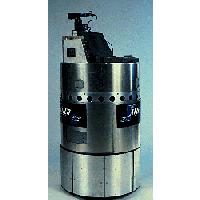Xavier

This Project is no longer active.
Xavier was designed and built by CMU graduate students in 1993. The overall goal was to develop autonomous mobile robots that can operate reliably over extended periods of time, can learn and adapt to their environments, and can interact with people in a socially acceptable manner.
Over the years, Xavier has been used in many research projects. It was one of the first mobile robots to navigate using POMDP (Partially Observable Markov Decision Process) models, a technique that has since become quite popular due to its ability to tolerate noise. Xavier was the first autonomous mobile robot to be commanded from the Web, where users could send Xavier to various offices, take pictures, and tell knock-knock jokes. Xavier has since been used to investigate issues of multi-robot cooperation (the Mercator, DIRA, and TRESTLE projects) and human-robot social interaction.
Xavier is built on top of a 24-inch diameter, four-wheeled, synchro-drive base, built by Real-World Interfaces. Sensors include bump panels, a Denning sonar ring, a Nomadics laser light striper, and twin cameras mounted on a Directed Perception pan/tilt head for stereo vision. On-board computation consists of two 400 MHz computers and a new 1 GHz computer, all connected to each other via Ethernet and connected to the outside world via a Wavelan wireless card. Xavier runs a distributed, concurrent software system under the Linux operating system.
current head
current contact
past staff
- Lonnie Chrisman
- Joaquin Lopez Fernandez
- Richard Goodwin
- David Hershberger
- Nak Yong Ko
- Sven Koenig
- Yasushi Nakauchi
- Joseph O'Sullivan
- Jose Maria Plaza
- Dong Jin Seo
- Sebastian Thrun




